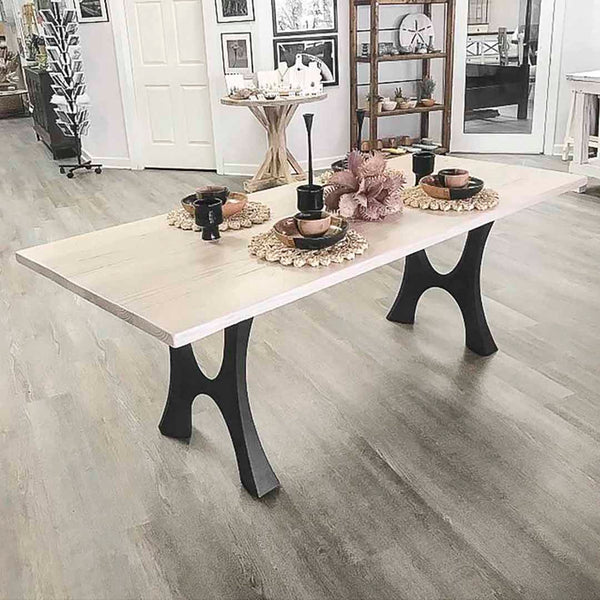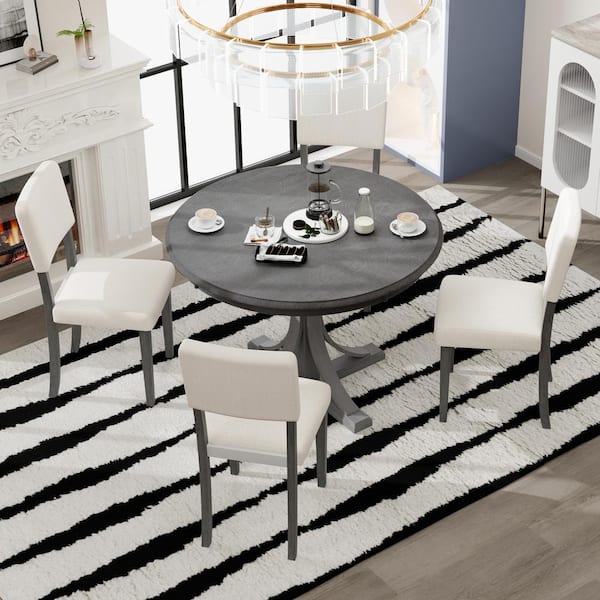Creative Ideas for Replacing or Refurbishing Your Dining Room Table Legs
Creative Ideas for Replacing or Refurbishing Your Dining Room Table Legs
Blog Article
From Typical to Modern: Find the Perfect Dining-room Table Legs for Your Style
While classic designs such as cabriole and transformed legs evoke a sense of timeless refinement, contemporary designs like barrette and geometric alternatives present a chance for striking aesthetic rate of interest. As you think about these components, the question continues to be: how can you effortlessly incorporate these diverse leg designs to create a harmonious dining experience?
Comprehending Table Leg Styles
The range of eating area table leg designs can considerably affect both the aesthetic appeals and capability of the space. Each leg design contributes unique functional functions and visual elements, satisfying diverse layout choices and usage needs. Recognizing these designs is essential for picking the appropriate dining table that lines up with your general interior design vision.
As an example, tapered legs supply a clean, timeless appearance that can boost a space's elegance, while stand bases supply security and maximize legroom, making them perfect for smaller sized areas. Barrette legs, a hallmark of mid-century modern design, introduce a commercial style, permitting a ventilated, open feel. Similarly, trestle legs evoke rustic appeal, providing robust assistance and a feeling of timelessness.
Furthermore, the selection of materials plays a considerable function. Wooden legs can bring heat and structure, whereas steel choices typically convey a streamlined, modern vibe. Ultimately, recognizing table leg styles is essential for producing a cohesive eating location that shows personal style while making certain practicality and convenience. By thoughtfully taking into consideration these elements, you can boost both the practical and visual allure of your dining area.
Typical Table Leg Options
When picking dining room table legs, conventional alternatives commonly embody timeless style and workmanship. These layouts show an abundant heritage and a dedication to top quality, making them ideal for those that appreciate classic visual appeals.
One of one of the most legendary standard leg designs is the cabriole leg, defined by its stylish curved shape. This style frequently includes ornamental carvings and is most commonly discovered in Queen Anne and Chippendale furniture. An additional popular option is the transformed leg, which flaunts a collection of smooth, rounded shapes that supply a timeless appearance while preserving stability.
Moreover, the straight leg, while simple, provides a strong and basic structure that can blend seamlessly with a selection of tabletop designs. For those drawn to ornate detailing, claw-and-ball feet legs stimulate a sense of majesty and can function as a stunning prime focus in any kind of dining room.
Last but not least, pedestal bases, although not strictly legs, give a different standard choice that enables enough legroom and can be magnificently carved. Each of these standard leg designs adds to the general atmosphere of a dining-room, weding function with visual appeal.

Modern Table Leg Styles
Modern table leg styles use a diverse variety of designs that stress tidy lines and innovative materials. These styles usually prioritize performance while working as striking focal factors within an eating space. Minimal appearances prevail, with legs crafted from products such as steel, glass, and crafted timber, which add to a ventilated and modern feeling.
One preferred design is the barrette leg, defined by its slim, conical framework that gives security without overwhelming the table top (dining room table legs). This style is commonly located in mid-century modern-day furnishings and can effortlessly complement various table forms. Another trend is using geometric shapes, where legs might handle angular or asymmetrical forms, adding visual rate of interest and a touch of creativity

Blending Styles for Distinct Areas
Frequently, homeowners look for to create distinct dining rooms that show their individual design by mixing numerous style aspects. This approach enables the consolidation of YOURURL.com varied appearances, resulting in an unified yet distinctive atmosphere. For circumstances, pairing a rustic wooden table with streamlined, modern-day metal legs can produce a distinctive comparison that raises the space's overall allure.
In addition, incorporating vintage table legs with contemporary tabletops can evoke a feeling of history while preserving a modern sensibility. Such mixes not just showcase specific taste yet likewise motivate creativity, allowing property owners to curate a room that really feels both individual and inviting.
Color plays an important function in this mixing procedure; choosing table legs that complement or comparison with the existing color design can enhance visual passion. For instance, whitewashed legs can soften the boldness of a dark table surface, see page developing a well balanced aesthetic.
Tips for Choosing the Right Legs
Selecting the right table legs is vital for attaining both capability and aesthetic appeal in your dining area. Begin by considering the overall style of your area. Traditional settings gain from legs that include elaborate makings or transformed styles, while contemporary spaces might call for sleek, minimal styles.
Next, examine the height and security of the legs. dining room table legs. Basic table vary between 28 to 30 inches in elevation, so make certain the legs enhance this measurement for convenience. In addition, robust products, such as hardwood or steel, can enhance stability and durability
Review the leg form as well-- options consist of directly, tapered, or stand designs. Straight legs offer a timeless appearance, while tapered legs can include a touch of sophistication. Pedestal bases supply sufficient legroom and are suitable for smaller sized rooms.
Conclusion
In summary, picking the ideal dining area click over here table legs requires mindful factor to consider of both modern-day and conventional designs. Traditional options such as cabriole and transformed legs supply classic elegance, while modern-day designs like hairpin and geometric shapes give a contemporary touch. By harmonizing leg design, elevation, and product with the total décor, a natural and welcoming atmosphere can be accomplished. Inevitably, the picked table legs ought to show the wanted aesthetic, boosting the dining experience within the space.
The variety of dining room table leg styles can dramatically affect both the appearances and capability of the area. Ultimately, recognizing table leg styles is vital for producing a natural eating location that mirrors individual design while guaranteeing usefulness and convenience.One of the most renowned traditional leg designs is the cabriole leg, identified by its elegant bent form. Straight legs supply a traditional appearance, while tapered legs can include a touch of style.In recap, selecting the ideal dining area table legs requires careful consideration of both modern and typical styles.
Report this page